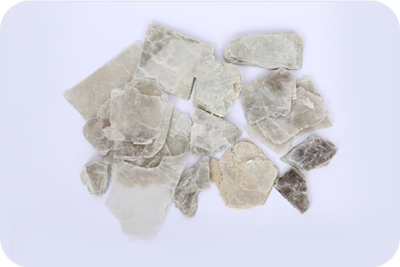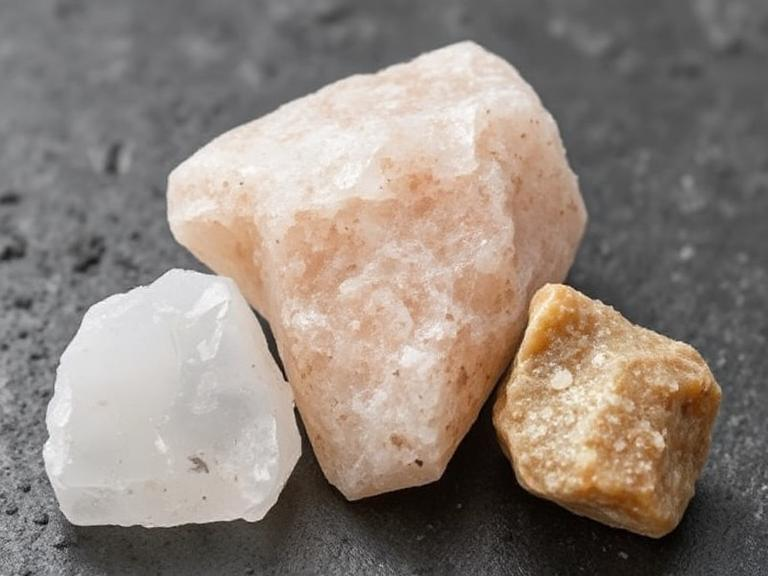Table of Contents
- Introduction
- Overview of Quartz, Mica, and Feldspar
- Chemical and Physical Properties
- Formation and Geological Occurrence
- Industrial and Commercial Uses
- Visual and Textural Differences
- Side-by-Side Comparison
- About AUKI MICA: High-End Mica Sheet Supplier
- Summary Table
Introduction
Quartz, mica, and feldspar are three of the most common minerals found in the Earth’s crust. They are essential components of many types of rocks and are widely used in industrial and commercial applications. Understanding the differences among them helps geologists, manufacturers, and hobbyists choose the right material for specific applications.

Overview of Quartz, Mica, and Feldspar
What is Quartz?
Quartz is a hard, crystalline mineral composed of silicon and oxygen atoms (SiO₂). It is the second most abundant mineral on Earth and is found in a wide range of environments.
What is Mica?
Mica refers to a group of sheet silicate minerals known for their layered structures and excellent insulating properties. Mica can be split into thin sheets, making it ideal for thermal and electrical insulation.

What is Feldspar?
Feldspar is a group of rock-forming minerals that make up more than 50% of Earth’s crust. It is a significant component in igneous, metamorphic, and sedimentary rocks and is often used in ceramics and glassmaking.
Chemical and Physical Properties
Quartz
- Chemical Formula: SiO₂ (Silicon Dioxide)
- Hardness: 7 on the Mohs scale
- Luster: Vitreous
- Color: Transparent to white, sometimes pink, purple (amethyst), or gray
Mica
- Chemical Formula: Varies (common types include muscovite KAl₂(AlSi₃O₁₀)(OH)₂ and biotite)
- Hardness: 2–3 on the Mohs scale
- Luster: Pearly to vitreous
- Color: Silver, gold, brown, green, or black
Feldspar
- Chemical Formula: KAlSi₃O₈ – NaAlSi₃O₈ – CaAl₂Si₂O₈
- Hardness: 6–6.5 on the Mohs scale
- Luster: Vitreous to pearly
- Color: White, pink, gray, or brown
Formation and Geological Occurrence
Quartz
Quartz forms in igneous, metamorphic, and sedimentary rocks. It often occurs as veins or crystals and is resistant to weathering, which makes it common in sand and sediment.
Mica
Mica forms primarily in igneous and metamorphic rocks. Due to its perfect basal cleavage, it appears in thin, elastic sheets or flakes.
Feldspar
Feldspar crystallizes from magma and is present in intrusive and extrusive igneous rocks such as granite and basalt. It can also form during metamorphism.
Industrial and Commercial Uses
Quartz Uses
- Electronics (oscillators, semiconductors)
- Glassmaking
- Timekeeping (quartz watches)
- Optics and lenses
- Construction materials (sand, gravel)
Mica Uses
Mica is valued for its thermal and electrical insulating properties, as well as its flexibility and resistance to heat.
- Insulating materials for electronics
- Stove windows and heating elements
- Decorative lampshades
- Cosmetics (shimmer in powders)
- Industrial gaskets and spacers
Feldspar Uses
- Glass and ceramics production
- Fillers in paints, plastics, and rubber
- Glazing materials
- Construction aggregate
Visual and Textural Differences
- Quartz: Glassy, transparent to translucent, no cleavage.
- Mica: Flaky, sheet-like texture, easily cleaved into thin layers.
- Feldspar: Often cloudy or opaque, blocky crystals with two cleavage planes.
Side-by-Side Comparison
| Property | Quartz | Mica | Feldspar |
|---|---|---|---|
| Chemical Composition | SiO₂ | Silicate minerals (varied) | K/Na/Ca-Aluminosilicates |
| Hardness (Mohs) | 7 | 2–3 | 6–6.5 |
| Cleavage | No cleavage | Perfect cleavage in one direction | Two cleavages at 90° |
| Luster | Vitreous | Pearly to vitreous | Vitreous to pearly |
| Typical Colors | Clear, white, purple | Silver, gold, brown, black | Pink, white, gray |
| Main Uses | Glass, electronics, watches | Insulation, cosmetics, decor | Ceramics, glass, fillers |
About AUKI MICA: High-End Mica Sheet Supplier
AUKI MICA is a leading supplier of high-end mica sheet insulating materials based in China. With direct access to mining resources in Pakistan and Afghanistan, and strong relationships with V1-grade mica mines in Africa and India, AUKI MICA ensures top-quality natural mica materials.
After a strict sorting process at the mines, mica is sent to Chinese factories for advanced processing into various finished mica products for export worldwide. AUKI MICA is committed to providing custom mica solutions tailored to your specific industrial needs.
Key Products
- Gauge Glass Mica
- Mica Transistor
- Mica Spacer
- Mica Washer
- Mica Disc
- Lampshade Mica
- Mica Wave Plates
- Stove Mica Windows
- Mica Strainer Core
If your business relies on high-performance mica insulation, AUKI MICA offers premium-grade options with professional customization and reliable global shipping.
Summary Table
| Mineral | Main Features | Common Uses | Hardness |
|---|---|---|---|
| Quartz | Hard, crystalline, glassy | Glassmaking, electronics, timepieces | 7 |
| Mica | Flaky, insulating, flexible | Electrical insulation, heat resistance, décor | 2–3 |
| Feldspar | Cloudy, blocky crystals | Ceramics, glass, fillers | 6–6.5 |

